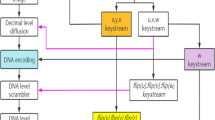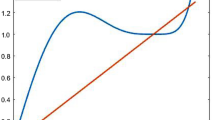Abstract
Sequences with low auto-correlation property have been applied in code-division multiple access communication systems, radar and cryptography. Using the inverse Gray mapping, a quaternary sequence of even length N can be obtained from two binary sequences of the same length, which are called component sequences. In this paper, using interleaving method, we present several classes of component sequences from twin-prime sequences pairs or GMW sequences pairs given by Tang and Ding in 2010; or two, three or four binary sequences defined by cyclotomic classes of order 4. Hence we can obtain new classes of quaternary sequences, which are different from known ones, since known component sequences are constructed from a pair of binary sequences with optimal auto-correlation or Sidel’nikov sequences.
Similar content being viewed by others
References
Fan P Z, Darnell M. Sequences Design for Communication Applications. Australia and New Zealand: Jacaranda Wiley Ltd., 1996. 5–15
Golomb S W, Gong G. Signal Design for Good Correlation: for Wireless Communication. Cambridge: Cryptography and Radar Cambridge University Press, 2005. 1–438
Lüke H D, Schotten H D, Hadinejad-Mahram H. Binary and quadriphase sequence with optimal autocorrelation: a survey. IEEE Trans Inf Theory, 2003, 49: 3271–3282
Schotten H D. Optimum complementary sets and quadriphase sequences derived form q-ary m-sequences. In: Proceedings of IEEE International Symposium on Information Theory, Ulm, 1997. 485
Lüke H D, Schotten H D. Odd-perfect almost binary correlation sequences. IEEE Trans Aerosp Electron Syst, 1995, 31: 495–498
Green D H, Green P R. Polyphase-related prime sequences. IEEE Proc Comput Digit Tech, 2001, 148: 53–62
Li N, Tang X H, Helleseth T. New M-ary sequences with low autocorrelation from interleaved technique. Des Codes Cryptogr, 2014, 73: 237–249
Sidelnikov V M. Some k-vauled pseudo-random sequences and nearly equidistant codes. Probl Inf Trans, 1969, 5: 12–16
Tang X H, Lindner J. Almost quadriphase sequence with ideal autocorrelation property. IEEE Signal Process Lett, 2009, 16: 38–40
Yang Z, Ke P H. Quaternary sequences with odd period and low autocorrelation. Electron Lett, 2010, 46: 1068–1069
Yang Z, Ke P H. Construction of quaternary sequences of length pq with low autocorrelation. Cryptogr Commun Discret Struct Boolean Funct Seq, 2011, 3: 55–64
Tang X H, Ding C. New classes of balanced quaternary and almost balanced binary sequences with optimal autocorrelation value. IEEE Trans Inf Theory, 2010, 56: 6398–6405
Kim Y-S, Jang J-W, Kim S-H, et al. New quaternary sequences with optimal autocorrelation. In: Proceedings of the IEEE International Conference on Symposium on Information Theory, Seoul, 2009. 286–289
Lüke H D, Schotten H D, Hadinejad-Mahram H. Generalised Sidelnikov sequences with optimal autocorrelation properties. Electron Lett, 2000, 36: 525–527
Kim Y-S, Jang J-W, Kim S-H, et al. New construction of quaternary sequences with ideal autocorrelation from Legendre sequences. In: Proceedings of the IEEE international conference on Symposium on Information Theory, Seoul, 2009. 282–285
Jang J W, Kim Y S, Kim S H, et al. New quaternary sequences with ideal autocorrelation constructed from binary sequences with ideal autocorrelation. In: Proceedings of IEEE International Symposium on Information Theory, Seoul, 2009. 278–281
Tang X H, Gong G. New constructions of binary sequences with optimal autocorrelation value/magnitude. IEEE Trans Inf Theory, 2010, 56: 1278–1286
Krone S M, Sarwate D V. Quadriphase sequences for spread spectrum multiple access communication. IEEE Trans Inf Theory, 1984, IT-30: 520–529
Acknowledgements
The work of Wei SU was supported by National Science Foundation of China (Grant No. 61402377), and in part supported by Open Research Subject of Key Laboratory (Research Base) of Digital Space Security (Grant No. szjj2014-075), and Science and Technology on Communication Security Laboratory (Grant No. 9140C110302150C11004). The work of Yang YANG was supported by National Science Foundation of China (Grants Nos. 61401376, 11571285), and Application Fundamental Research Plan Project of Sichuan Province (Grant No. 2016JY0160). The work of Zhengchun ZHOU and Xiaohu TANG was supported by National Science Foundation of China (Grants Nos. 61672028, 61325005).
Author information
Authors and Affiliations
Corresponding author
Additional information
Conflict of interest The authors declare that they have no conflict of interest.
Rights and permissions
About this article
Cite this article
Su, W., Yang, Y., Zhou, Z. et al. New quaternary sequences of even length with optimal auto-correlation. Sci. China Inf. Sci. 61, 022308 (2018). https://doi.org/10.1007/s11432-016-9087-2
Received:
Accepted:
Published:
DOI: https://doi.org/10.1007/s11432-016-9087-2




